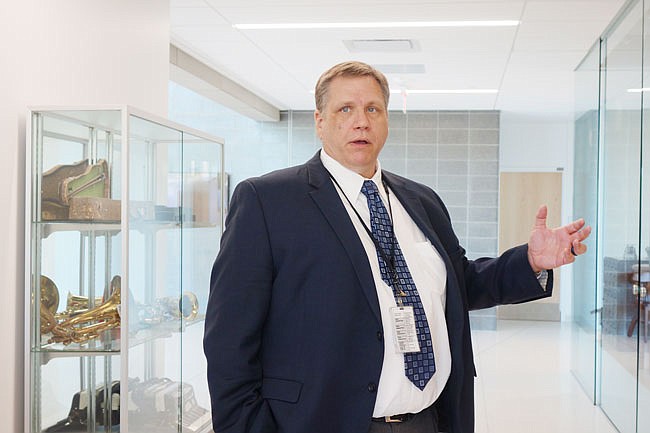Locals got their first and last look inside the Nixon Forensic Center on Wednesday.
The newest building at the Fulton State Hospital, the high-security NFC will house some 300 patients. Wednesday's open house comes at the tail end of years of building, decades of lobbing and tens of millions of dollars spent - Chief Operating Officer Andy Atkinson estimated the NFC alone cost $140 million to construct.
Though the building is essentially complete now, move-in at the building is set for July.
"With all the technology and systems, we're having to do quite a bit of staff training," Atkinson said.
After move-in, most of the facility will be closed to everyone but the patients and the 700 staff members who take care of them.
A few key areas will remain open to the public, however. The striking glass-and-steel lobby houses several display cases of historical items. Having opened in 1851, the FSH has plenty of history. There are musical instruments played by patients past, an old rotary telephone labeled "emergency," and, most poignantly, a logbook recording patients' personal possessions upon admittance.
"We wanted to maintain some historic presence here," Atkinson said.
There's also a large theater/conference room. Atkinson said area companies are encouraged to book the room for trainings and conferences. He hopes inviting the public into the FSH will help reduce stigma around mental health and mental health treatment facilities.
"The Fulton community has always embraced the Fulton State Hospital," said Debra Walker, acting deputy director of the Missouri Department of Mental Health.
Aside from becoming a patient, the other main way inside the Nixon Forensic Center is as an employee. Atkinson said he hopes the new facility will encourage that as well.
Old facilities, such as the Biggs Maximum Security Center (slated for demolition after its patients move into the NFC) were cramped, full of blind corners and simply unsafe. According to the MDMH, staff injuries at FSH are high, with Workers Compensation claims the highest of any facility in the state ($4 million per year).
"Where they are currently, if someone starts to become anxious or agitated, there's nowhere for other clients to go to get away from that situation," Atkinson added.
Staff retention is poor, with the hospital hiring an average of 30-50 employees per month.
New hiring practices, such as increasing the rate of new-hire classes, have made hiring easier, Atkinson said. He said a bright, airy and safe new facility should increase new applications and retention.
"The closer we get to move in, the more people we've had applying," he said. "We really hope this will improve our retention as well as recruitment. The new safety features are bound to increase job satisfaction."
The details
By now, most regular readers of the paper have seen the basic statistics for the facility. Spread across nearly half a million square feet are 12 residential halls; a large "treatment mall" with stores and a teaching kitchen; gymnasiums; a chapel; two large outdoor areas; multiple smaller courtyard; a medical center and more.
There's room for four treatment programs with 75 patients each, each targeting the particular needs of a subset of the FSH's population. Patients each get their own room - tiny and minimally furnished, though each hall has a community space with multiple TVs, an outdoor courtyard and a gaming room.
What isn't immediately obvious from the news releases and pictures are all the tiny details, the details designed to make the NFC a safe and pleasant place to live andwork.
Take the doors - about as mundane an object as possible. Rather than a traditional knob or handle, the door's opening mechanism lies flush. There's no way to tie a rope around them for the purpose of harming oneself or someone else, Atkinson explained. (The same goes for the hooks at the gym: they're rubber and bend if anything heavier than a towel tugs at them.)
The door to each patient's room usually opens inward, but with the flip of a switch can open outward too.
"There's no way to barricade yourself into a room," Atkinson said.
A nurse's station in each residential wing is positioned so the on-duty staff member can see down all the halls at once; the barrier around it is 5 feet tall and curved in a way that would prevent someone from climbing over.
Then there's the furniture. Some would look at home in any office, but try to pick up one of those chairs to cause mischief and you'll discover it weighs 30 pounds. Others are made of blocky gray foam that's surprisingly cozy and lacking in hard edges.
"They're very comfy but it would take an elephant to move it," Walker said.
Natural light floods every hall and room. Slots cut into cinderblock reduce annoying echoes. Separate dining areas make sure everyone gets meals at the same time. Overhead, maintenance people have their own floor - no need to mingle with patients to fix a lightbulb.
Atkinson said the building's designers visited several new state hospital facilities when planning NFC.
"We took the best of each one," he said.

